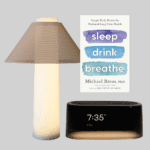As a parent, it’s natural to have questions or concerns about a newborn baby’s sleep habits. During the first few weeks and months, it may seem like your newborn’s sleep patterns are erratic and unpredictable, and your own lack of sleep may make it even more challenging to find relief for your family.
Developing an understanding of your baby’s sleep cycles and patterns can help you navigate changes through the first year of their lives and beyond. Babies aren’t born with a fully formed circadian rhythm, it develops over time. During their first 6 months, babies undergo a number of changes in their sleep habits before they begin to follow a regular day-night sleep schedule.
If it feels like you are struggling with your child’s sleep patterns, do not worry — this is common among newborns and babies, and every child differs. You can take action to help your baby sleep through the night in several ways, including sleep training, improving their bedtime routine, and talking with a doctor.
What Are Baby Sleep Cycles?
A baby’s sleep cycle involves three distinct phases: active sleep, quiet sleep, and transitional sleep. Each phase is defined by certain body movements, changes in breathing patterns, and variations in brain activity.
Throughout a period of sleep, a newborn moves through these phases in a predictable pattern. Referred to as a baby’s sleep cycle, this pattern repeats about every 60 minutes over a period of several hours. A baby’s sleep cycle is primarily characterized by longer durations of rapid eye movement (REM) sleep, which researchers believe is crucial for meeting developmental milestones.
- Active phase: In the active phase, REM sleep occurs. During this phase, babies’ eyes move quickly under their eyelids, and their muscles might randomly twitch. It is normal for breathing patterns to become temporarily staggered, even stopping for 5 to 10 seconds before rapidly increasing again.
- Quiet phase: During the quiet phase, babies experience non-rapid eye movement (NREM) sleep. There are no muscle spasms, and their eyes stop shifting beneath their eyelids. As they drift deeper into sleep, it may become harder to wake them up.
- Transitional phase: Transitional sleep describes the periods between waking, active, and quiet sleep phases. During the transitional phase, infants may experience a mix of movements, breathing patterns, and brain activity that are associated with other phases of sleep.
Over their first year, babies spend less time in active sleep and more time in quiet sleep, similar to children and adults. And as they grow and mature, babies learn how to move more smoothly between phases of sleep, which correlates with shorter periods of transitional phase sleep.
How Is A Baby's Sleep Cycle Different From An Adult's?
A baby’s sleeping habits and needs differ significantly from an adult’s. The daily sleep-wake pattern of a newborn is mainly driven by a developing central nervous system and the need to eat. Newborn babies tend to spend most of the day sleeping, usually for two to four hours at a time, waking for shorter periods of one to two hours in order to eat.
When newborn babies fall asleep, they move directly into a phase of active REM sleep, unlike adults, who begin a sleep cycle in NREM. Infants also spend an equal amount of time in active and quiet sleep, while adults typically experience less REM sleep and more NREM sleep.
While babies alternate between active and quiet sleep periods, adults experience sleep in four stages. Infants more commonly struggle to connect their sleep cycles, experiencing periods of transitional sleep, while children and adults are typically more comfortable cycling between phases of their sleep.
Baby Sleep Cycles And Sleep Schedules During The First Year
Over the first year of your child’s life, their sleep habits and schedule will change multiple times. Though every baby is different, they will require less overall sleep on a daily basis and spend more time awake as they age. While newborns typically sleep between 10 to 18 hours each day, after 6 to 9 months, they may begin to sleep about 10 to 12 hours.
The length of sleep periods also changes. Newborns sleep in shorter stretches, but by 4 months of age, a baby may sleep for six to eight hours at a time. In their first year, babies may take up to four naps per day, but over time, they will need fewer naps. For example, by the time they are 18 months old, children generally only need one nap per day.
Changes in sleep-wake patterns also occur as your baby ages. At around 2 months, an infant may concentrate the amount of their sleep more at night, rather than spreading it throughout the day. Additionally, while newborns tend to spend equal amounts of time in active and quiet sleep, they spend less time in active sleep as they age.
How To Help Your Baby Connect Sleep Cycles
Research suggests that during the transition between sleep cycles, people are in a state of being both awake and asleep, and more easily aroused from sleep. Babies can initially struggle to transition from one sleep cycle to the next, but may learn to self-soothe when they wake up between cycles to return to restful sleep.
Around 3 to 4 months of age, some babies undergo a period of sleep regression. In this phase, babies’ sleep patterns change significantly. Stretches of quiet sleep lengthen, and they are more likely to wake up in and between these lighter periods of sleep.
Practice Sleep Training
Sleep training is a common method for helping a baby improve their sleep. This practice is intended to encourage an infant to fall back to sleep at night without contact from a parent or caregiver. This typically involves allowing the baby to cry for a period of time in their crib, rather than immediately intervening to console them.
Sleep training methods can vary. Some parents and caregivers choose to return and comfort a crying baby at increasing intervals of time. But, this has the potential to affect a baby’s expectations for receiving comfort, causing further distress.
Some choose to allow their children to “cry it out,” only returning in cases of emergency. However, prolonged crying can be stressful for the whole family and may cause a baby to become too distraught to fall asleep.
Shop the Best Crib MattressesEstablish a Bedtime Routine
Research suggests that sticking to a bedtime routine can help infants sleep longer and more consistently through the night. A bedtime routine involves repeating the same set of activities about an hour before bedtime most days of the week. Activities may include bathing, cuddling, singing lullabies, and dimming the lights.
When putting your infant to bed, they should have their own sleep surface that is firm and flat, with just a fitted sheet. Bed-sharing increases the risk of serious injury to a baby and is not considered safe. Instead, parents and caregivers should consider room-sharing to remain close to their child at a safe distance. Doctors recommend this method in the first few months of your newborn’s life, rather than bed-sharing.
Talk to Your Doctor
Experts recommend that a baby should see a pediatrician for a well-child visit periodically throughout the first year of life. During these visits, the pediatrician will perform a physical exam, check their growth and development, and discuss their daily routine, including sleep habits.
If you have any concerns about your child’s sleep, it is important to let your pediatrician know. Questions about sleep are one of the most common reasons parents reach out for help, so pediatricians are generally prepared to provide information about what to expect and guidance for alleviating sleep problems in babies.
When discussing your child’s sleep habits with the pediatrician, it can be helpful to share any observations about their body movements and breathing patterns, including snoring. You may also wish to discuss how long sleep periods last and whether your baby has trouble falling asleep and staying asleep.
References
The Sleep Doctor Forum: Real Experiences, Real Connections
Continue the discussion on the Sleep Doctor Forum. Connect with experts and fellow forum members on CPAP, sleep apnea, and all things sleep. A priceless resource that’s free to join.






















